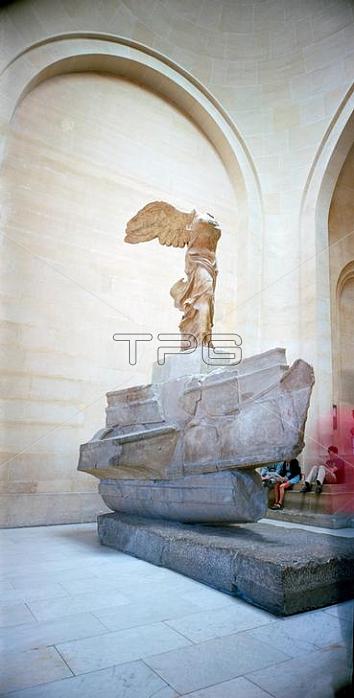
The Winged Victory of Samothrace; also called the Nike of Samothrace; is a 2nd century BC marble sculpture of the Greek goddess Nike (Victory). Since 1884; it has been prominently displayed at the Louvre and is one of the most celebrated sculptures in the world.The Nike of Samothrace; discovered in 1863; created around 190 BC. Modern excavations suggest that the Victory occupied a niche in an open-air theater and also suggest it accompanied an altar that was within view of the ship monument of Demetrius I Poliorcetes (337冒283 BC). Rendered in white Parian marble; the figure originally formed part of the Samothrace temple complex dedicated to the Great gods; Megaloi Theoi. It stood on a rostral pedestal of gray marble from Lartos representing the prow of a ship for its graceful balance and for the rendering of the figure's draped garments; compellingly depicted as if rippling in a strong sea breeze. Nike of Samothrace is seen as an iconic depiction of triumphant spirit and of the divine momentarily coming face to face with man. The statue now stands over a supplementary platform over the prow that allows a better contemplation but was not present in the original. The different degree of finishing of the sides has led scholars to think that it was intended to be seen from three-quarters on the left.A partial inscription 鈥楻hodios' (Rhodian); indicating that the statue was commissioned to celebrate a naval victory by Rhodes; at that time the most powerful maritime state in the Aegean.Yearc. 220冒190 BCTypeParian marbleDimensions328脢cm (129脢in)LocationLouvre; ParisIN THE PHOTO: VIEW FROM THE 1/4 RIGHT
| px | px | dpi | = | cm | x | cm | = | MB |
Details
Creative#:
TOP18355232
Source:
達志影像
Authorization Type:
RM
Release Information:
須由TPG 完整授權
Model Release:
No
Property Release:
No
Right to Privacy:
No
Same folder images:

 Loading
Loading